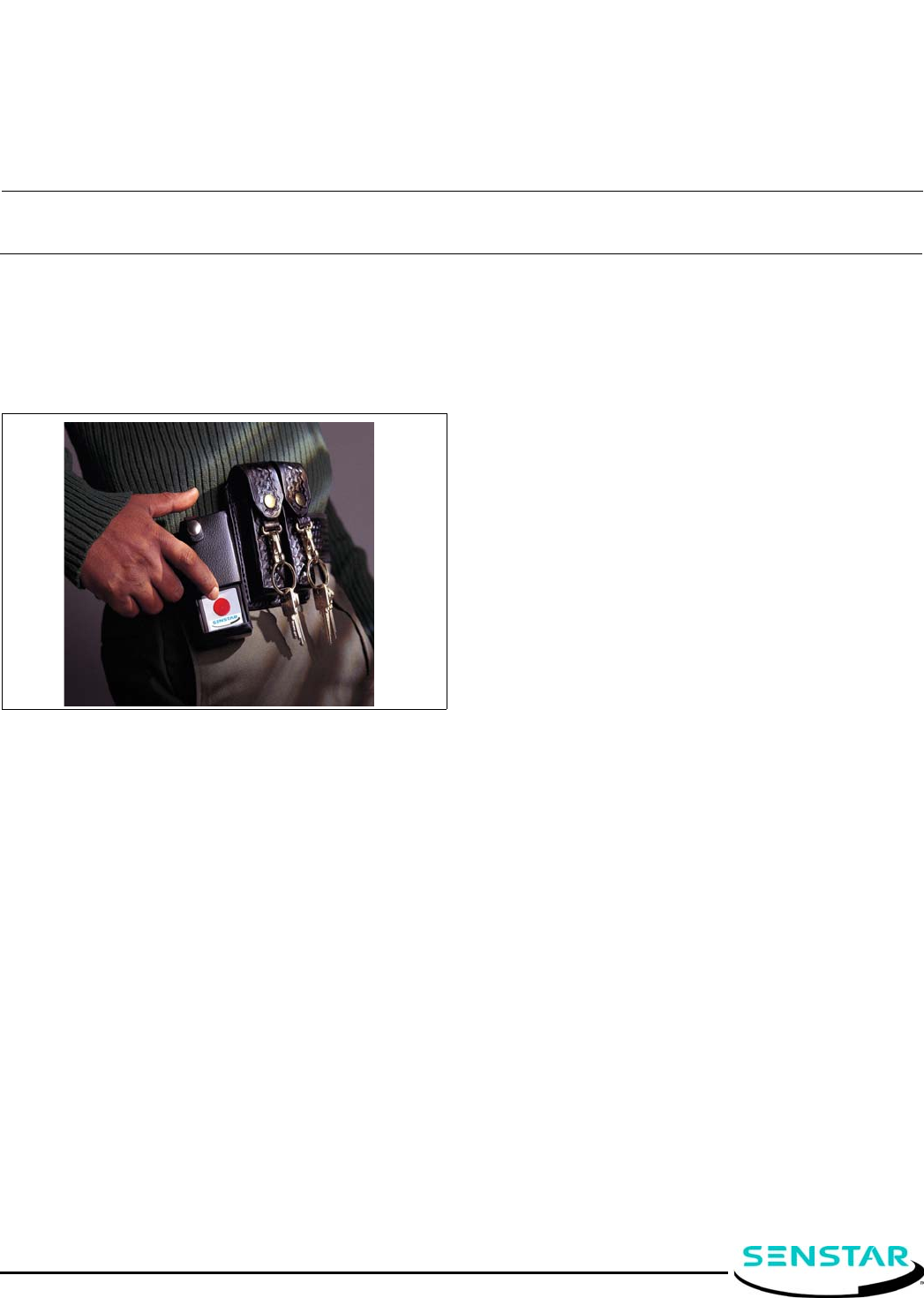Senstar T1FG1601 Personal protection device (PPT) User Manual PPD User Instructions
Senstar Corporation Personal protection device (PPT) PPD User Instructions
Senstar >
Contents
- 1. User Manual
- 2. User Manual II
User Manual II

Introduction
This instruction sheet details the procedures for using
Senstar’s Personal Protection Device (PPD) with the
Flash Personal Portable Alarm System and the Flare
Personal Alarm Locating System.
The PPD is a belt-worn radio transmitter, which
communicates a personal duress condition to a security
station computer when activated. With the Flash system,
a unique PPD ID displays on the Flash computer’s
screen when a PPD is activated. With the Flare system, a
unique PPD ID displays along with a site map, which
indicates the specific location of the emergency
transmission. Pressing a large, easily accessible button
activates the PPD transmitter. Optionally, a pull-pin and
lanyard, or a configurable man-down tilt alarm feature will
activate the PPD.
Features
•accessible push-button with raised center-dot
•optional pull-pin with lanyard (tamper activation)
•optional user-configurable man-down transmission
•activation tilt angle: 40º to 65º
•tilt time before activation: 2 to 20 seconds
•warning tones - ON or OFF
•transmit and reset options: single auto-reset,
repeat auto-reset, or repeat manual-reset
•internal antenna
•user-configurable PPD ID (requires transmitter
programmer)
•minimum one year battery life (with three test
transmissions per day)
•automatic low-battery alert transmission (minimum
15 day battery life after the first low battery alert)
•tamper-resistant screws for battery compartment and
electronics
•durable black ABS plastic housing
•belt-worn leather holster with tamper-resistant
security snaps
Specifications
•power: 9-volt alkaline battery
•dimensions: 12 L X 5 W X 2.5 D cm (4.7 X 2 X 1 in.)
•weight: 200 g (7 oz.)
•transmission range: 1 km (0.6 mile) line of sight
(100% coverage within prescribed areas)
•temperature: -40º to +50º C (+122º F)
•humidity: 0 to 90% non-condensing
•frequency: international public safety band
(450 to 470 MHz) configurable for local regulations
Wearing the PPD
Wear the PPD in an easy to reach position on your belt,
with the logo and push button facing away from your body.
If you also wear a radio, wear the PPD on the opposite side
of your body.
Be careful not to activate the PPD when putting it on or
taking it off.
If your PPD includes the optional pull-pin and lanyard,
connect the lanyard to a belt loop after putting the PPD on
your belt.
The snaps on the PPD holster’s belt loop are security
snaps that open only by pulling up from the bottom. Do
NOT attempt to open the snaps by pulling on the holster, or
its belt loop (see Figure 2).
Figure 1: Belt-worn PPD
Flash™/Flare®
Instruction sheet #1
June 6, 2016
T1DA0103-001, Rev D
PPD User Instructions

page 2 T1DA0103-001, Rev D
Flare, Senstar and the Senstar logo are registered trademarks and Flash is a trademark of Senstar Corporation. Copyright © 2016, 2008, 2004. All
rights reserved. The information in this instruction sheet is subject to change without notice. Printed in Canada.
website: www.senstar.com email: info@senstar.com
1. Place the PPD into its holster with the activation
button exposed through the opening in the holster,
and close the top snap.
2. Open the two belt loop snaps on the back of the
holster and insert the loop under your belt.
3. Close the two belt loop snaps over your belt.
Activating the PPD
Do NOT cover the PPD with your hand while pressing the
red button (see Figure 1).
Wearing the PPD under your clothing will not affect the
transmission.
If you accidentally activate your PPD, report the accidental
activation immediately.
If a PPD transmits a low-battery message, take the unit out
of service immediately, and have its battery replaced.
Center your finger on the raised dot and press the red
button to activate the PPD. The PPD transmits its unique
ID code once per activation. After activation, the PPD’s
unique ID displays on the security control station
computer. The Flare system also identifies the specific
location of the transmission. When the PPD’s battery
discharges to the low-battery level, the PPD
automatically transmits a low-battery message. As a
precaution, the low battery message repeats (with the
duress transmission) at each subsequent activation.
Optional activation
A transmitter with a pull-pin and lanyard is available for
added security. If the transmitter is forcibly removed, the
pull-pin is also removed and the PPD sends a duress
transmission.
Ensure that the pull-pin is fully installed in its socket at all
times.
A transmitter with a man-down tilt feature is available for
added security. When the PPD tilts beyond a preset
angle for a preset duration the unit automatically sends a
duress transmission. The man-down PPD can be
configured to emit an audible beep (to alert the user)
when it tilts beyond the preset angle. The tilt angle, tilt
duration and audible beep are user-configurable.
PPD testing
Test the PPD at the beginning of each shift. Follow the
facility’s established procedure for PPD testing.
If a test activation is NOT reported on the security control
station computer, take the PPD out of service immediately.
Maintenance and care
•Do NOT submerge the PPD or expose it to heavy
rain.
•Although durable, the PPD is not shock-proof or
unbreakable.
•A special screwdriver is required to open the battery
compartment. Do NOT attempt to open the battery
compartment unless using the correct tool.
•If the PPD requires cleaning, use only a soft damp
cloth to wipe the unit (not wet). Do NOT use solvents
or detergents on the PPD.
•If the holster is saturated with moisture replace the
holster until it dries. A wet holster can affect Flare’s
location accuracy.
•Store PPDs, which include the man-down option, in
an upright position.
Figure 2: Opening the security snaps